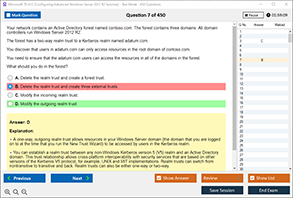In the world of networking and data transmission, it is essential to understand the different components of a network frame, as they play a crucial role in ensuring data is transmitted correctly and efficiently. One such component is the Frame Check Sequence (FCS) field. Whether you're preparing for a networking exam or aiming to deepen your understanding of network protocols, understanding the purpose of the FCS field in a frame is fundamental.
In this blog post, we’ll take an in-depth look at the purpose of the FCS field in a frame, its role in data integrity, and its significance in the world of networking. By the end of this article, you will have a clear understanding of how the FCS field contributes to ensuring reliable communication over networks.
What is the FCS Field?
The Frame Check Sequence (FCS) is a crucial element in data frames, particularly in Ethernet frames. The FCS is used for error detection, helping to ensure that the data has been transmitted correctly and hasn’t been corrupted during transit. The FCS field is usually located at the end of the data frame.
This field is a part of the trailer of a frame and consists of a cyclic redundancy check (CRC), which is a mathematical algorithm used to detect errors in data transmission. The CRC value is calculated by the sender before the transmission and is stored in the FCS field. The receiver then calculates the CRC value on the received data frame. If the calculated CRC matches the value in the FCS, it indicates that the frame was transmitted without error. If the values don't match, it means the frame has been corrupted, and the receiver requests a retransmission.
Purpose of the FCS Field in a Frame
The FCS field serves several important functions in a network frame. The primary purposes of the FCS field are:
- Error Detection: The primary role of the FCS field is to detect errors that may occur during data transmission. The FCS field uses a CRC algorithm to ensure that the data transmitted is intact. If an error occurs during the transmission, such as a bit being flipped due to noise or signal degradation, the receiver can identify the error by comparing the CRC values.
- Integrity Assurance: By verifying the integrity of the data, the FCS field ensures that the data has not been tampered with or corrupted. This is crucial for applications requiring high data integrity, such as financial transactions or secure communications.
- Data Verification: In cases where the transmitted data frame fails the error check, the receiver can discard the corrupted frame and request the sender to resend it. This helps maintain the accuracy of the data being transferred.
- Improved Reliability: With the FCS field, networks can offer more reliable communication by preventing the delivery of corrupted data, which might lead to application-level issues or failures.
- Part of Error Control Mechanism: The FCS works alongside other mechanisms like flow control and retransmission protocols. These protocols help ensure that data is sent and received correctly in unreliable networks.
How Does the FCS Work?
The FCS field works by using a Cyclic Redundancy Check (CRC) algorithm. Here’s how it works:
- Sender Side: Before sending the data frame, the sender calculates the CRC for the frame’s data. The sender then appends this CRC value to the end of the frame in the FCS field.
- Receiver Side: Upon receiving the frame, the receiver calculates the CRC for the data received. If the calculated CRC matches the value stored in the FCS field, the receiver assumes the data is correct. If the two values differ, the receiver knows that there was an error in transmission.
Why is the FCS Important in Networking?
- Prevents Corruption: In noisy environments or on long-distance connections, data can become corrupted. The FCS helps detect such errors before they cause significant issues.
- Improves Network Efficiency: With FCS-enabled error detection, networks do not have to send and receive data multiple times due to corrupted frames, saving bandwidth and improving network throughput.
- Provides Reliability: In modern networking, especially in real-time systems such as VoIP (Voice over IP), FCS ensures the delivery of reliable data, which is essential for performance.
- Supports High-Speed Communication: High-speed networks rely on error-checking mechanisms like the FCS field to maintain communication integrity without compromising speed. This is especially crucial in environments where large amounts of data need to be transferred quickly and accurately.
FCS Field in Different Network Protocols
While the FCS field is commonly used in Ethernet and other Layer 2 (data link layer) protocols, it can also be seen in various other network protocols. Some of the most common use cases include:
- Ethernet Frames: Ethernet frames include an FCS field at the end of the frame. Ethernet uses a 32-bit CRC to detect errors in the frame.
- PPP (Point-to-Point Protocol): PPP also uses an FCS field to detect errors. In PPP, the FCS is appended to the data being sent over the link.
- Wi-Fi (IEEE 802.11): Wi-Fi networks also utilize FCS for error detection. Wi-Fi protocols like IEEE 802.11 employ an FCS field to ensure the integrity of frames in wireless communication.
- ATM (Asynchronous Transfer Mode): ATM uses a similar approach to error detection with an FCS field, ensuring that data cells are transmitted correctly.
Common Errors Detected by the FCS Field
The FCS field can help detect several types of errors that might occur during the transmission of data. These errors include:
- Bit Errors: A bit error happens when a single bit in a data frame changes from 0 to 1 or vice versa. This could be caused by electrical noise or signal degradation.
- Burst Errors: Burst errors occur when several bits in a sequence are altered. These errors are typically caused by interference in the communication channel.
- Frame Loss: While the FCS field doesn’t directly detect frame loss, it does help in identifying if the receiver received a corrupted frame, prompting a retransmission.
- Dropped Frames: If a frame is missing an FCS or the FCS doesn’t match, the frame may be dropped, requiring a retransmission.
Sample Questions and Answers
- What is the primary purpose of the FCS field in a frame?
- A) To ensure proper routing of the frame
- B) To provide error detection for the transmitted data
- C) To indicate the start and end of the frame
- D) To encrypt the frame content
- Answer: B) To provide error detection for the transmitted data
- Which algorithm is used by the FCS field to detect errors in a frame?
- A) SHA-256
- B) Cyclic Redundancy Check (CRC)
- C) MD5
- D) AES
- Answer: B) Cyclic Redundancy Check (CRC)
- Where is the FCS field located in a typical Ethernet frame?
- A) At the beginning of the frame
- B) At the middle of the frame
- C) At the end of the frame
- D) It is not part of the Ethernet frame
- Answer: C) At the end of the frame
- What happens if the FCS field in a frame does not match the calculated CRC value?
- A) The frame is accepted, and the data is processed
- B) The receiver requests the frame to be resent
- C) The receiver ignores the error
- D) The data is automatically corrected
- Answer: B) The receiver requests the frame to be resent



